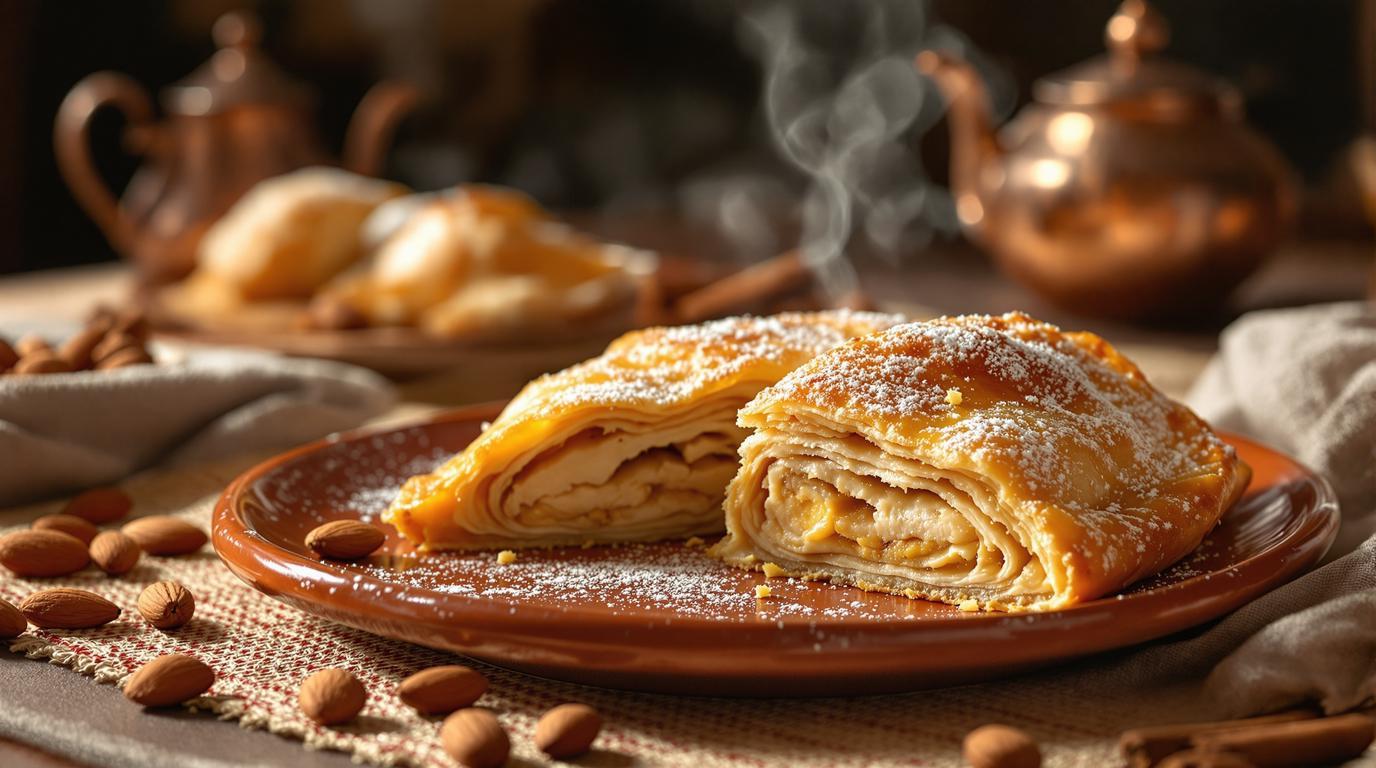The first time I encountered authentic Moroccan pastilla was during a culinary expedition through Fez nearly two decades ago. I watched in awe as a grandmother’s weathered hands delicately layered paper-thin pastry with a fragrant chicken mixture, her movements practiced and precise after countless celebrations. “The secret,” she whispered to me with a knowing smile, “is in the balance—savory and sweet must dance together, not fight.” That lesson has stayed with me through countless restaurant kitchens and remains at the heart of this magnificent dish that transforms humble ingredients into a celebration centerpiece. 🇲🇦
The Cultural Tapestry of Pastilla 📖
Pastilla (sometimes spelled b’stilla) represents Morocco’s rich culinary heritage, with roots tracing back to Andalusian influences when Moorish immigrants arrived with their culinary traditions. What began as a pigeon pie for nobility eventually transformed into the chicken version most commonly enjoyed today. This savory-sweet pie embodies the Moroccan philosophy of contrasting flavors—spiced meat, aromatic herbs, crunchy almonds, and a whisper of sweetness, all embraced by delicate pastry. It’s traditionally served at weddings and special occasions, symbolizing sweetness and prosperity. 🕌
Essential Ingredients 🧾
The beauty of pastilla lies in transforming everyday ingredients into something extraordinary:
- 2 lbs (900g) bone-in chicken thighs
- 2 large onions, finely diced
- 3 garlic cloves, minced
- 1 tablespoon fresh ginger, grated
- 2 teaspoons Ras el Hanout spice blend
- 1 teaspoon ground cinnamon, plus extra for dusting
- ½ teaspoon ground turmeric
- Pinch of saffron threads, crushed (about 20 threads)
- 3 tablespoons fresh parsley and cilantro, chopped
- 4 large eggs, beaten
- 1½ cups (150g) blanched almonds, toasted
- 3 tablespoons powdered sugar, plus extra for dusting
- 2 tablespoons orange blossom water
- 12 sheets phyllo pastry
- ¾ cup (170g) unsalted butter, melted
Chef’s Note: Can’t find Ras el Hanout? Create your own by mixing 1 teaspoon each of ground cumin, coriander, and paprika with ½ teaspoon each of cinnamon, ginger, and black pepper. The flavor won’t be identical but will capture the aromatic essence of Moroccan cuisine. 🌶️
Step-by-Step Instructions 📝
1. Prepare the Chicken Filling 🍗
Season chicken thighs generously with salt and pepper. In a large, heavy-bottomed pot, heat 2 tablespoons olive oil over medium-high heat. Sear the chicken, skin-side down first, until golden brown on both sides (about 4-5 minutes per side). Transfer to a plate.
In the same pot, reduce heat to medium and add onions, cooking until translucent (about 8 minutes). Add garlic and ginger, cooking for 1 minute until fragrant. Stir in Ras el Hanout, cinnamon, turmeric, and saffron. Return chicken to the pot along with 2 cups of water or chicken stock. Bring to a simmer, cover, and cook for 35-40 minutes until the chicken is fall-apart tender.
2. Create the Custard Base 🥣
Remove chicken from the pot and set aside to cool. Once cool enough to handle, shred the meat, discarding skin and bones. Bring the remaining cooking liquid to a boil and reduce by half. Lower heat to medium-low and slowly pour in beaten eggs while stirring constantly. You’re creating a silky custard, not scrambled eggs, so maintain gentle heat and continuous motion. Once thickened (about 3-4 minutes), fold in the shredded chicken and herbs. Allow mixture to cool completely.
3. Prepare the Almond Layer 🌰
Pulse toasted almonds in a food processor until coarsely ground. Mix with powdered sugar, 1 teaspoon cinnamon, and orange blossom water.
4. Assemble the Pastilla 🥧
Preheat oven to 375°F (190°C). Brush a 9-inch (23cm) round cake pan with melted butter. Layer 6 sheets of phyllo pastry, one by one, brushing each with butter and arranging them so they overhang the pan’s edges in different directions. Spread the almond mixture over the base, followed by the cooled chicken filling. Fold the overhanging phyllo edges over the filling. Top with 6 more phyllo sheets, each brushed with butter and tucked into the pan’s edges.
5. Bake to Golden Perfection 🔥
Brush the top with remaining butter and bake for 25-30 minutes until deeply golden. Allow to cool for 10 minutes before carefully inverting onto a serving platter. Dust generously with powdered sugar and create a decorative cinnamon pattern on top.
Chef’s Secret Techniques 🤫
The magic of pastilla lies in these crucial details that elevate it from good to magnificent:
- Temperature control: Allow the filling to cool completely before assembly; hot filling will make your pastry soggy. 🌡️
- Egg technique: When adding eggs to the reduced broth, maintain a temperature just below simmering and stir constantly in a figure-eight pattern to create a smooth custard rather than scrambled eggs. 🥚
- Phyllo management: Keep unused sheets covered with a slightly damp kitchen towel while working to prevent drying. Work confidently but quickly. 🧵
Serving & Presentation Tips 🍽️
In Morocco, pastilla is often the star of the feast before the main course. Serve wedges alongside a bright salad like my Hungarian-inspired goulash or complement it with paprika-kissed Hungarian chicken for a fusion dinner party. For lighter fare, pair with cloud-like potato gnocchi dressed simply with herb butter.
If you enjoy working with flavorful doughs, try your hand at homemade wontons or crispy Japanese karaage as your next culinary adventure.
Remember what my Moroccan cooking mentor taught me: pastilla isn’t just food—it’s a story told through flavors. The sweetness represents joy; the savory elements symbolize life’s substance; the flaky layers remind us of life’s complexity. When you serve this golden creation dusted with sugar and cinnamon, you’re not just offering a meal but sharing centuries of tradition, celebration, and the beautiful art of balance. ✨
